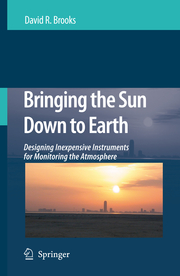Detailansicht
Bringing the Sun Down to Earth
Designing Inexpensive Instruments for Monitoring the Atmosphere
ISBN/EAN: 9789048179558
Umbreit-Nr.: 1609984
Sprache:
Englisch
Umfang: xii, 157 S., 15 farbige Illustr., 157 p. 15 illus.
Format in cm:
Einband:
kartoniertes Buch
Erschienen am 19.10.2010
Auflage: 1/2008
- Zusatztext
- In 1998, my colleague, Forrest Mims, and I began a project to develop inexpensive handheld atmosphere monitoring instruments for the GLOBE Program, an international environmental science and education program that began its operations on Earth Day, 1995. GLOBE's goal was to involve students, teachers, and scientists around the world in authentic partn- ships in which scientists would develop instrumentation and experimental protocols suitable for student use. In return, data collected by students and their teachers would be used by scientists in their research. This kind of collaboration represented a grand vision for science education which had never before been attempted on such a scale, and we embraced this vision with great enthusiasm. Between 1998 and 2006, Forrest Mims and I collaborated on the development of several instruments based on Mims' original concept of using light emitting diodes as spectrally selective detectors of sunlight, which was first published in the peer-reviewed literature in 1992. These instruments have evolved into a set of tools and procedures for monitoring the transmission of sunlight through the atmosphere, and they can be used to learn a great deal about the composition of the atmosphere and the dynamics of the Earth/atmosphere/sun system. If measurements with these instruments are made properly, they have significant scientific value, as well.
- Kurztext
- Bringing the Sun Down to Earth is intended for teachers, students, and anyone who wants to understand their environment. It provides a unique perspective to monitoring the role of the sun and Earth's atmosphere in maintaining our planet as a place hospitable to advanced life as we understand it. The book first presents some science background about the sun and Earth's atmosphere and then describes the kinds of measurements that can be made with inexpensive equipment to study how solar radiation interacts with the atmosphere on its way to Earth's surface. Such measurements are critical to understanding the forces that will modify Earth's climate during the 21st century. The book describes in detail how to design, build, calibrate, and use inexpensive instruments for measuring solar radiation, ranging from total radiation from the entire sky to narrow spectral bands of radiation travelling along a path directly from the sun. Students and their teachers will learn a great deal about weather, the seasons, and the atmosphere, and they will develop a much better understanding of how to measure the physical world around them. When these instruments are calibrated and used properly, they can be used for serious research that produces results comparable to data from other ground-based sources provided by the science community.
